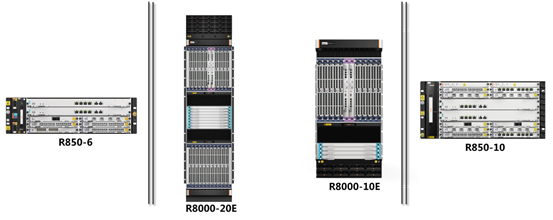With the maturity of 4G commercialization and the popularization of Internet applications in the world, new business models have given birth to applications such as eMBB, uRLLC and mMTC; it is predicted that the mobile data traffic of 5G network will increase 1000 times compared with 4G network in the near future;Nowadays, the peak data rate of 4G networks is around 1 Gbit/s. In the 5G era, the data rate will be improved to 10 Gbit/s to meet the users’ requirements. The development of business drives the continuous evolution of mobile backhaul network,which has gradually evolved to IP/MPLS bearer network from the original SDH rigid pipes and is evolving toward SDN-oriented network. The application of new services also put forward higher requirements for IP bearer network.
Large Bandwidth
In order to reduce the latency of eX2 interface, the access layer network architecture changes from ring network to mesh network, which requires more optical fiber resources, and the access layer equipment needs to support larger rate ports. In the early stage of 5G network deployment, the access layer device ports are 10GE-based and support 25GE, and the convergence layer and core layer devices should support high-density 100GE interfaces.
Low Latency
The latency of S1 interface is required to be less than 2ms, while the latency of X2 interface is required to be less than 1ms. The forwarding delay requirements for fronthaul and mid-haul are less than 5us. Compared with 4G, 5G should have 5 to 10 times of decreasing in the latency from the terminal device to the core network.
High-precision Time Synchronization
The joint transmission technology of MIMO and base station will be used, which requires high-precision time synchronization technology.
Network Slicing
Diversified services bring about diversified network.According to the requirements of the specific scenario, the combination mode of soft pipeline and hard pipeline is used to meet the ultra-low latency needs and reliability of services.Meanwhile, the network slicing should be strictly isolated. The maintenance of any slice does not affect other slices, including the normal operation of service, addition and deletion operations, network upgrade, security isolation, and attack isolation.

SDN/NFV
In the 5G era, operators need a network architecture supporting unified operation and unified deployment to achieve full service control and operation. The deployment of SDN/NFV technology can optimize data transmission path to effectively reduce network transmission delay. The construction of service-oriented architecture can meet the differentiated requirements of services and improve the deployment efficiency of services.

Compared with 4G network, the stricter requirements of bandwidth, latency, time synchronization and new technologies will bring huge challenges to the transport network. In addition to the technology evolution, operators are more focused on investment, hoping to extend the life cycle of 4G infrastructure networks. FiberHome has been committed to the development of the optical transmission network. In order to meet the challenges of 5G, FiberHome has been continuously investing on the self-design NP chipset in IP field for more than 5 years, and all major routers adopted NP programmable architecture to develop. In order to meet the network capacity requirements of different network hierarchy, FiberHome developed high-end router R8000E series and R850 series; R8000E Tbit super-capacity router support 400 platform, which can smoothly evolve to support 800G per slot to meet the capacity requirements of the aggregation layer, core layer, and core network edge devices. R850 series support 10GE, 25GE, 50GE and 100GE service interfaces and SR, Flex-E and new technologies such as SDN/NFV, which can provide end-to-end networking with R8000E series and R8000 series to meet the requirements of 3G/4G/5G mobile services and broadband metropolitan area access services. FiberHome also actively cooperate with china Unicom, China Mobile and China telecom , launching 5G IPRAN pilot projects to build solid foundation for 5G commerce.